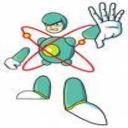Yahoo Answers is shutting down on May 4th, 2021 (Eastern Time) and beginning April 20th, 2021 (Eastern Time) the Yahoo Answers website will be in read-only mode. There will be no changes to other Yahoo properties or services, or your Yahoo account. You can find more information about the Yahoo Answers shutdown and how to download your data on this help page.
Trending News
Yoyo linear velocity physics question. (energy method)?
A spherical Yo-Yo is released from rest 1.2 m above the ground. The Yo-Yo unwinds as it falls. What is the Yo-Yo's linear velocity right before it hits the ground? Use energy method.
2 Answers
- electron1Lv 76 years ago
Since the sphere is rotating as it falls to the ground, it has linear and rotational kinetic energy. Since we are using the energy method, the magnitude of its final linear and rotational kinetic energy will be equal to its initial potential energy.
PE = m * 9.8 * 1.2 = m * 11.76
Linear KE = ½ * m * v^2
Rotational KE = ½ * I * ω^2
For a sphere, I = 2/5 * m * r^2
Since we need to determine the final linear velocity, let’s convert ω to v by dividing by r.
ω^2 = v^2/r^2
Rotational KE = ½ * 2/5 * m * r^2 * v^2/r^2 = 0.2 * m * v^2
Total KE = 0.7 * m * v^2
Set this equal to the initial potential energy and solve for v.
0.7 * m * v^2 = m * 11.76
v^2 = 11.76 ÷ 0.7 = 16.8
v = √16.8
This is approximately 4.1 m/s.
- Randy PLv 76 years ago
It has energy mgh where h = 1.2 m.
This is turned into kinetic energy. There is linear kinetic energy (1/2)mv^2 and there is rotational kinetic energy (1/2) Iw^2 where w = angular velocity = v/r and I = moment of inertia of a sphere. Write down the formula for moment of inertia of a sphere. Add the two kinetic energies and set them equal to mgh. Solve for v.





